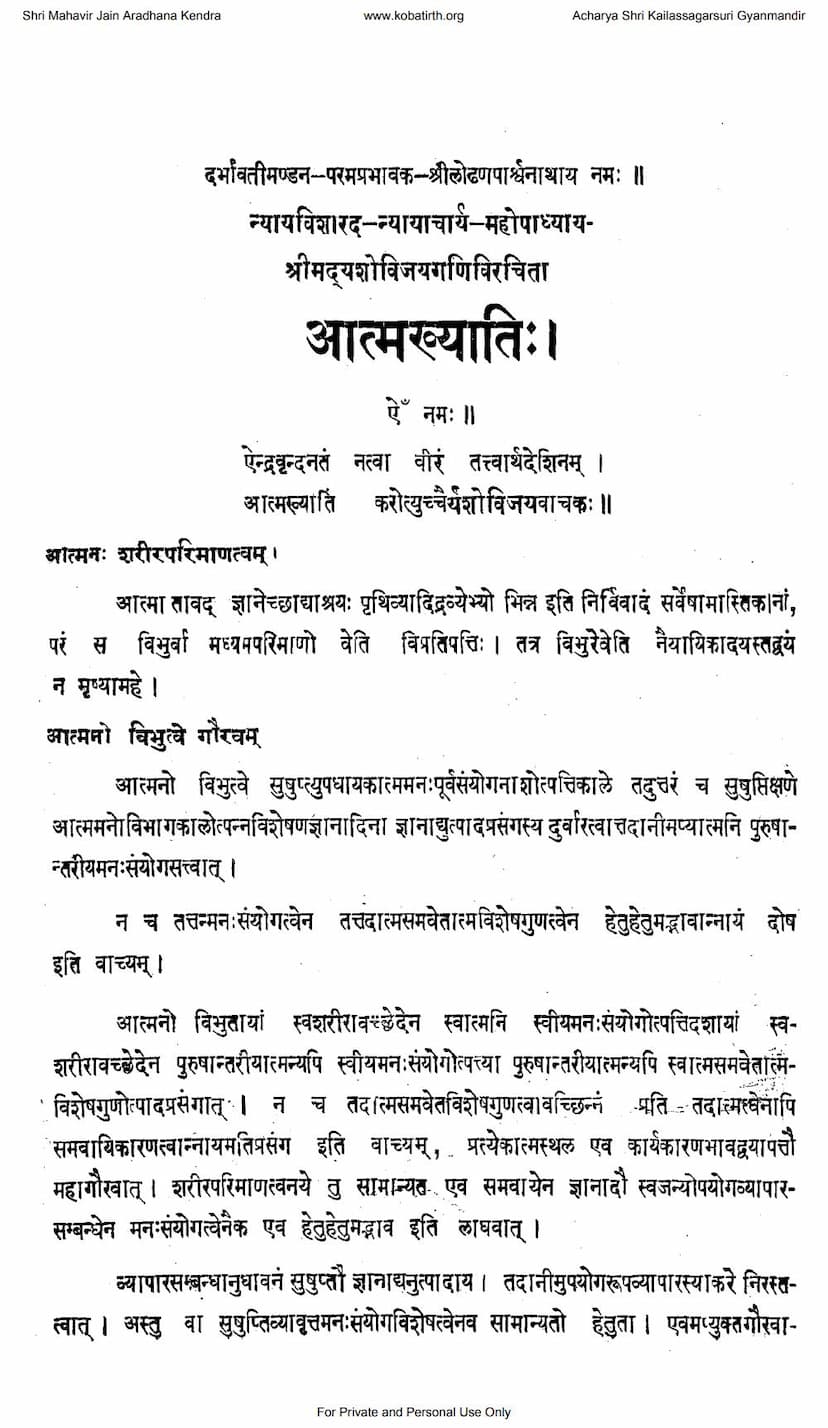Atmakhyati
Added to library: September 1, 2025

Summary
This is a comprehensive summary of the Jain text "Atmakhyati" by Yashovijay Gani, based on the provided pages:
Book Title: Atmakhyati (आत्मख्यातिः) Author: Yashovijay Gani (यश<bos> vijay Gani)
Core Argument: The Atomicity of the Soul (आत्मनः शरीरपरिमाणत्वम्)
The central debate addressed in this text is whether the soul (Atman) is all-pervading (vibhū - विभु) or of the same size as the body (sharira-parimāṇa - शरीरपरिमाण). Yashovijay Gani argues strongly for the latter, presenting extensive logical arguments and refuting the all-pervading nature of the soul.
Key Arguments Against the Soul Being All-Pervading (Vibhū-tva):
- The Problem of Simultaneous Experience: If the soul were all-pervading, it would be impossible to explain why the soul experiences pleasure and pain only in relation to a specific body and not simultaneously in relation to all bodies. The text elaborates on the complexities of how a pervading soul would interact with multiple minds and bodies, leading to paradoxical situations regarding the origination of knowledge and consciousness.
- The Issue of Inert Bodies: If the soul were all-pervading, it would be difficult to explain why a dead body, while still existing, does not have conscious experience. The author argues that the absence of consciousness in a dead body is due to the lack of a connection with the soul, not because the soul itself ceases to exist or becomes inert.
- The Cycle of Rebirth (Sansara): The very concept of transmigration and rebirth becomes problematic if the soul is all-pervading. The author questions how a soul that is everywhere could then take on a new body in a different realm. The notion of "appropriation" (parigraha - परिग्रह) of a new body is analyzed, and the author finds issues with the philosophical definitions that would apply to an all-pervading soul.
- The Illusion of Universality in Arguments: Many arguments for the soul's pervasiveness are critiqued as being based on flawed reasoning or misinterpretations of experience. The author systematically breaks down these arguments, highlighting logical fallacies and inconsistencies.
- The Self-Perception of the Soul: The direct, immediate self-awareness of "I am" (aham - अहम्) is presented as evidence that the soul is localized within its own body. The author argues that this self-perception is limited to the soul's own embodiment.
- The Problem of Parts and Wholes: If the soul were all-pervading, it would be difficult to explain how parts of the body (like limbs) can be perceived as belonging to the soul without the entire soul being affected in the same way. The author emphasizes the Jain doctrine that while there is a connection between soul and body, they are not identical.
Arguments for the Soul Being Body-Sized (Sharira-Parimāṇa):
- Simplicity and Parsimony (Lāghava - लाघव): The theory that the soul is body-sized is argued to be simpler and more parsimonious, avoiding the complex and often contradictory explanations required for an all-pervading soul.
- Direct Experience: The direct experience of "I am this body" or "I am experiencing within this body" is presented as primary evidence. The soul's experience is felt to be contained within its physical form.
- Explanation of Limitations: The body-sized nature of the soul naturally explains the soul's limitations in experiencing specific things and its confinement to a particular body at any given time.
Detailed Discussions and Refutations:
The text delves into highly detailed philosophical discussions, dissecting various concepts and arguments, including:
- The Nature of Perception: How we perceive objects, the role of senses, the mind, and the soul in knowledge acquisition.
- Causation (Kāraṇatva - कारणत्व): The analysis of different types of causes (samavāyi, asamavāyi, nimitta) and their application to various phenomena.
- The Existence and Nature of Samavāya (समवाय): A significant portion of the text is dedicated to refuting the existence of samavāya (inseparable or inhering connection) as a distinct category of relationship, as proposed by other philosophical schools. The author presents numerous arguments to show that other forms of connection, or the nature of things themselves, can adequately explain perceived relationships.
- Theories of Causation for Material Objects: Extensive analysis of how composite objects are formed (e.g., from atoms, combinations of elements), the duration of actions and their effects, and the role of causality in transformation and destruction. This includes detailed discussions on concepts like pāka (cooking/transformation), saṁyoga (conjunction), and vibhāga (disjunction) in the context of physical substances.
- The Nature of Qualities (Guṇa - गुण): How qualities are inherent or acquired, and their relation to substances.
- The Concept of "Vaidharmya" (वैधर्म्य - Difference in properties) and "Sādṛśya" (सादृश्य - Similarity): Discussing how differences and similarities are perceived and what they imply about the nature of reality.
- The Doctrine of "Anēkānta" (अनेकान्त - Non-one-sidedness): The text implicitly upholds the Jain principle of anēkānta, suggesting that reality is multifaceted and cannot be fully grasped by a single viewpoint.
- Refutation of Other Philosophical Schools: Throughout the text, Yashovijay Gani engages with and refutes arguments from schools like Nyāya, Vaiśeṣika, and Vedānta, demonstrating the superiority of the Jain perspective.
Overall Tone and Style:
The "Atmakhyati" is characterized by its rigorous logical analysis, detailed argumentation, and comprehensive engagement with philosophical debates. It demonstrates a deep understanding of Jain philosophy and its systematic refutation of opposing views. The language is complex and technical, typical of scholarly philosophical works.
Significance:
This text is a significant contribution to Jain epistemology and ontology, particularly in its detailed defense of the atomicity of the soul and its refutation of the concept of samavāya. It showcases the logical prowess and philosophical depth of Jain scholars.